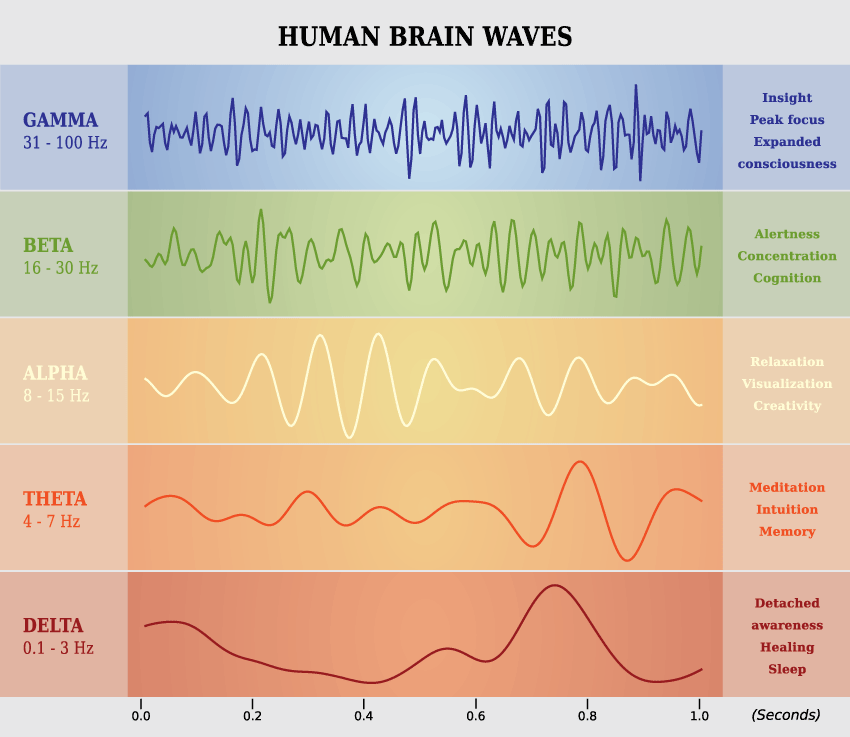Binaural Beats

 Binaural beats or binaural tones are auditory processing artifacts, or apparent sounds, the perception of which arises in the brain for specific physical stimuli. This effect was discovered in 1839 by Heinrich Wilhelm Dove, and earned greater public awareness in the late 20th century based on claims that binaural beats could help induce relaxation, meditation, creativity and other desirable mental states.
Binaural beats or binaural tones are auditory processing artifacts, or apparent sounds, the perception of which arises in the brain for specific physical stimuli. This effect was discovered in 1839 by Heinrich Wilhelm Dove, and earned greater public awareness in the late 20th century based on claims that binaural beats could help induce relaxation, meditation, creativity and other desirable mental states.
When listened to in stereo Binaural Beats create the "frequency following response" behaviour in the brain - basically the brain will "synchronize" with the frequency and produce the desired feeling or response. So when the beats & tones create a perceived - DELTA frequency for example - Since delta range is associated with relaxation and sleep, this has a relaxing effect.
The brain produces a phenomenon resulting in low-frequency pulsations in the amplitude and sound localization of a perceived sound when two tones at slightly different frequencies are presented separately, one to each of a subject's ears, using stereo headphones. A beating tone will be perceived, as if the two tones mixed naturally, out of the brain.
Binaural beats are of interest to neurophysiologists investigating the sense of hearing.
Binaural beats reportedly influence the brain in more subtle ways through Brainwave Entrainment and have been claimed to reduce anxiety and provide other health benefits such as control over pain.
Isochronic tones

 Creating pulsating beats that create a singular tone. Isochronic tones encourage brainwave frequencies to fall
into step with a frequency corresponding to the intended brain-state. Isochronic tones work by emitting sound at regular intervals: Regarded as the most effective tone-based Brainwave Entrainment method.
Creating pulsating beats that create a singular tone. Isochronic tones encourage brainwave frequencies to fall
into step with a frequency corresponding to the intended brain-state. Isochronic tones work by emitting sound at regular intervals: Regarded as the most effective tone-based Brainwave Entrainment method.
Isochronic tones are regular beats of a single tone used for Brainwave Entrainment. Similar to monaural beats, the interference pattern that produces the beat is outside the brain so headphones are not required for Brainwave Entrainment to be effective.
The contrast between noise and silence is more pronounced than the constant pulses of monaural beats, the stimulus is stronger and has a greater effect on Brainwave Entrainment.
Isochronic tones work by emitting sound at regular intervals. This excites the thalamus and causes the brain to duplicate the frequency of the Isochronic tones, changing its thought patterns.
Solfeggio Frequencies

 Solfeggio Frequencies are original sound frequencies that were apparently used in Ancient Gregorian Chants, such as the great hymn to St. John the Baptist, along with others that church authorities say were lost centuries ago. The chants and their special tones were believed to impart tremendous spiritual blessings when sung in harmony during religious masses.
Solfeggio Frequencies are original sound frequencies that were apparently used in Ancient Gregorian Chants, such as the great hymn to St. John the Baptist, along with others that church authorities say were lost centuries ago. The chants and their special tones were believed to impart tremendous spiritual blessings when sung in harmony during religious masses.
These powerful frequencies were rediscovered by Dr. Joseph Puleo as described in the book Healing Codes for the Biological Apocalypse by Dr. Leonard Horowitz.
The Solfeggio Frequencies:
- 396 Hz-Liberating Guilt and Fear
- 417 Hz-Undoing Situations and Facilitating Change
- 528 Hz-Transformation/Miracles (DNA Repair)
- 639 Hz-Connecting/Relationships
- 741 Hz-Awakening Intuition
- 852 Hz-Returning to Spiritual Order
- 936 Hz-Third Eye (Pinneal gland) Activation
Frequency 528, relates to the note MI on the scale and derives from the phrase “MI-ra gestorum” in Latin meaning “miracle.” Stunningly, this is the exact frequency used by genetic biochemists to repair broken DNA. Many scientists, health professionals, and energy researchers use 528Hz frequency in their work.

|

